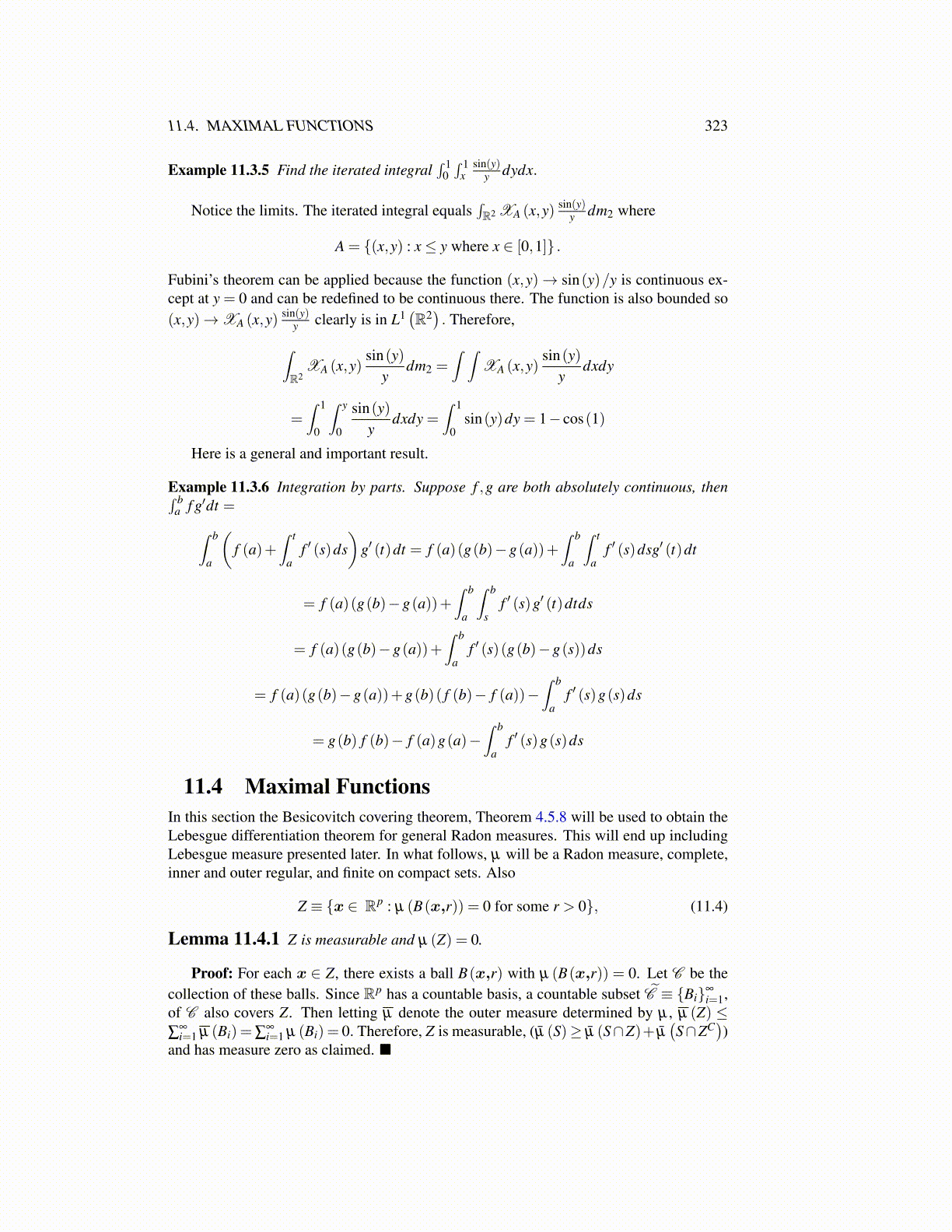
11.4. MAXIMAL FUNCTIONS 323
Example 11.3.5 Find the iterated integral∫ 1
0∫ 1
xsin(y)
y dydx.
Notice the limits. The iterated integral equals∫R2 XA (x,y)
sin(y)y dm2 where
A = {(x,y) : x≤ y where x ∈ [0,1]} .
Fubini’s theorem can be applied because the function (x,y)→ sin(y)/y is continuous ex-cept at y = 0 and can be redefined to be continuous there. The function is also bounded so(x,y)→XA (x,y)
sin(y)y clearly is in L1
(R2). Therefore,
∫R2
XA (x,y)sin(y)
ydm2 =
∫ ∫XA (x,y)
sin(y)y
dxdy
=∫ 1
0
∫ y
0
sin(y)y
dxdy =∫ 1
0sin(y)dy = 1− cos(1)
Here is a general and important result.
Example 11.3.6 Integration by parts. Suppose f ,g are both absolutely continuous, then∫ ba f g′dt =∫ b
a
(f (a)+
∫ t
af ′ (s)ds
)g′ (t)dt = f (a)(g(b)−g(a))+
∫ b
a
∫ t
af ′ (s)dsg′ (t)dt
= f (a)(g(b)−g(a))+∫ b
a
∫ b
sf ′ (s)g′ (t)dtds
= f (a)(g(b)−g(a))+∫ b
af ′ (s)(g(b)−g(s))ds
= f (a)(g(b)−g(a))+g(b)( f (b)− f (a))−∫ b
af ′ (s)g(s)ds
= g(b) f (b)− f (a)g(a)−∫ b
af ′ (s)g(s)ds
11.4 Maximal FunctionsIn this section the Besicovitch covering theorem, Theorem 4.5.8 will be used to obtain theLebesgue differentiation theorem for general Radon measures. This will end up includingLebesgue measure presented later. In what follows, µ will be a Radon measure, complete,inner and outer regular, and finite on compact sets. Also
Z ≡ {x ∈ Rp : µ (B(x,r)) = 0 for some r > 0}, (11.4)
Lemma 11.4.1 Z is measurable and µ (Z) = 0.
Proof: For each x ∈ Z, there exists a ball B(x,r) with µ (B(x,r)) = 0. Let C be thecollection of these balls. Since Rp has a countable basis, a countable subset C̃ ≡ {Bi}∞
i=1,of C also covers Z. Then letting µ denote the outer measure determined by µ , µ (Z) ≤∑
∞i=1 µ (Bi) =∑
∞i=1 µ (Bi) = 0. Therefore, Z is measurable, (µ̄ (S)≥ µ̄ (S∩Z)+ µ̄
(S∩ZC
))
and has measure zero as claimed. ■